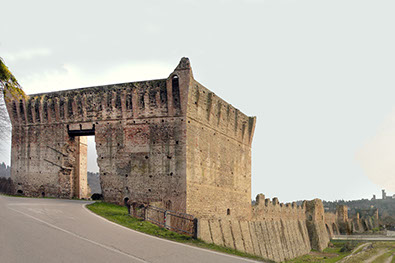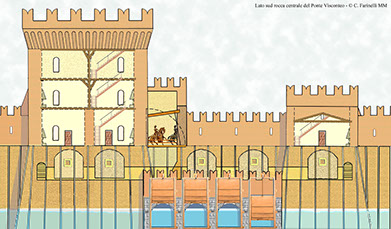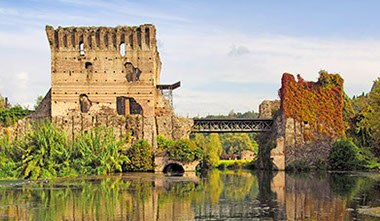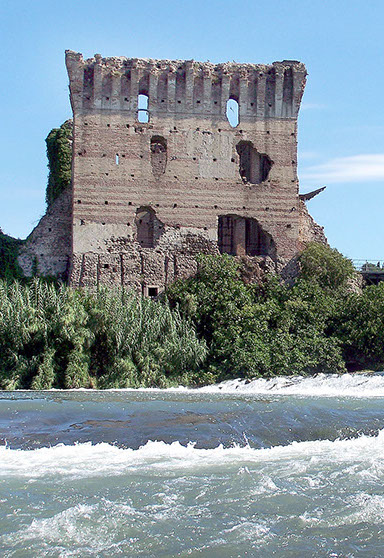Progetto di valorizzazione
del territorio di Valeggio sul Mincio
Ponte fortificato
Visconteo
XIV SECOLO
Dopo la conquista del veronese nel 1387, Gian Galeazzo Visconti (1341-1402), duca di Milano, realizzò una serie di opere difensive attorno alla strategica città di Verona per sostenere la sua espansione territoriale verso oriente e per fronteggiare la crescente influenza veneziana sulla terraferma veneta.
Nell’aprile del 1393, iniziarono i lavori di edificazione del più imponente monumento medievale valeggiano.
In principio, il Visconti intendeva deviare il corso del Mincio con uno sbarramento che avrebbe permesso il sollevamento delle acque del fiume e il loro deflusso nei fossati del Serraglio scaligero fino a farle confluire nel fiume Tione, lontano quasi sei chilometri.
Non riuscendo nell’intento, per insuperabili problemi tecnici, fu costretto a ridimensionare il progetto, cambiandone la destinazione d'uso: da Ponte-Diga in Ponte-Fortezza.
Il signore di Mantova, Francesco Gonzaga (1366-1407), sentendosi minacciato dai lavori sul Mincio, cercò in ogni modo di ostacolarli.
Il Visconti, ignorando le manovre dell’ex cognato mantovano, portò a termine rapidamente quanto aveva iniziato.
Il terrapieno del Ponte è formato da oltre 100.000 m3 di terreno, riportato dall’escavazione dei due fossati paralleli che fiancheggiavano la fortificazione; la quale è lunga più di 650 metri, alta sul piano campagna mediamente 8 metri e larga alla sommità 21 metri.
La grande rocca centrale, con le quattro bocche di deflusso e i magazzini sotterranei, fu la parte più complessa da realizzare.
All’inizio del XVII secolo, durante la grave crisi politica che la opponeva al governatore spagnolo di Milano, la Serenissima, temendo imminente la guerra, fece saltare le arcate sul fiume per togliere alle truppe spagnole la possibilità di superare il Mincio e dilagare nella pianura veneta.
Il Ponte, interrotto per tre secoli, nel 1930 è stato ricollegato con una campata in ferro e aperto al nascente traffico automobilistico.
Dal 1993, l’Associazione Ristoratori organizza ogni anno una grande tavolata su questo Ponte, con migliaia di commensali, per celebrare in questa suggestiva cornice medievale il vanto della gastronomia locale: i Tortellini di Valeggio.
Fortified Visconti Bridge
14th CENTURY
After the conquest of Verona’s territory in 1387, Gian Galeazzo Visconti (1341-1402), Duke of Milan, built a series of defensive constructions around the strategic city of Verona to support his territorial expansion towards the east and to confront the rising Venetian influence on the mainland of the Veneto region.
In April 1393, the works of the most imposing monument of Valeggio began. Firstly, Visconti wanted to deviate the flow of the river Mincio with a barrier which would have allowed the raising of the river’s water level and its outflow in the moats of the Scaligeri Serraglio (a fortified line), from where they would have flowed into the river Tione, almost six kilometers away.
Unable to succeed in his intent, due to insurmountable technical problems, Gian Galeazzo was obliged to downsize his project, changing its purpose: from a Dam-Bridge to a Fortress-Bridge.
The Duke of Mantua, Francesco Gonzaga (1366-1407), feeling menaced by the works on the river Mincio, tried to hinder them in any way possible.
Visconti, ignoring the scheming of his ex-brother-in-law, rapidly completed the work he had started.
The earthwork of the bridge is formed by more than 100.000 m3 of earth, coming from the excavation of the two parallel moats which flanked the fortification.
The latter is 650 meters long (711 yards), 8 meters high (8,7 yards) on the farmland level, and 21 meters (23 yards) wide at the top.
The big central stronghold, with four outflow points and the subterranean warehouses, was the most complex part to build.
At the beginning of the 17th century, the Most Serene Republic of Venice, during an arduous political crisis, opposing the Spanish governor in Milan, fearing the already inevitable war, blew up the arches on the river in order to prevent the Spanish troops from crossing the river Mincio and thus rapidly spread across the Veneto plain.
The bridge, unusable for centuries, was reconnected in 1930 with an iron span and opened to cars traffic.
Every year, since 1993, Valeggio’s Association of Restaurateurs organizes a vast feast on this bridge, with thousands of visitors, to celebrate in this evocative medieval setting, the pride of the local culinary art: Valeggio’s Tortellini.
Befestigte
Visconteo-Brücke
14. Jhr.
Mittelalterliche Route
Nach der Eroberung Veronas im Jahr 1387 ließ der Herzog von Mailand Gian Galeazzo Visconti (1341-1402) eine Reihe von Verteidigungsbauten um die strategische Stadt Verona errichten, die seine territoriale Expansion nach Osten unterstützen und den wachsenden Einfluss Venedigs auf dem venetischen Festland entgegenwirken sollten.
Im April 1393 begannen die Bauarbeiten des größten mittelalterlichen Monuments von Valeggio. Anfangs wollte Visconti den Lauf des Mincios durch ein Stauwerk umleiten, durch das die Gewässer des Flusses angehoben und in die Graben des Scaliger-Serraglio abfließen konnten, bevor sie in den fast sechs Kilometer entfernten Tirone-Fluss mündeten.
Wegen unüberwindbaren technischen Problemen musste das Projekt verkleinert und somit die Zweckbestimmung der Brücke von Brücke-Stauwerk in Brücke-Festung geändert werden. Da die Arbeiten am Mincio eine Gefahr für Francesco Gonzaga, Herr von Mantua (1366-1407), darstellten, versuchte er sie in jeder Weise zu behindern. Visconti ignorierte diese Tätigkeiten seines ehemaligen Schwagers aus Mantua und brachte rasch sein Vorhaben zu Ende.
Der Erddamm der Brücke besteht aus über 100.000 m3 Erde, der durch den Aushub von zwei parallel verlaufenden Gräben entstand, der entlang der 650 m langen Festung verläuft und auf der Landfläche durchschnittlich 8 m hoch und an der Spitze 21 m breit ist. Der Bau der großen zentralen Burg mit den vier Abflussöffnungen und die unterirdischen Lager waren am schwierigsten.
Am Beginn des 17. Jahrhunderts fürchtete die Seerepublik Venedig während der schweren politischen Krise mit dem spanischen Governator von Mailand den Ausbruch eines Krieges. Sie ließ die Brückenbögen über dem Fluss zerstören, damit die spanischen Truppen den Mincio nicht überqueren und in die Poebene einfallen konnten.
Die Brücke blieb über drei Jahrhunderte unterbrochen. Im Jahr 1930 wurde sie mit einem Eisenbogen wieder verbunden und für den aufkommenden Straßenverkehr geöffnet.
Seit 1993 organisiert der Verband der Gaststättenbetreiber jedes Jahr eine große Festtafel auf dieser Brücke mit tausenden Gästen, um in diesem eindrucksvollen mittelalterlichen Rahmen die Köstlichkeiten der lokalen Gastronomie zu zelebrieren: die Tortellini aus Valeggio.



© 2019
Comune di Valeggio sul Mincio (VR)
Associazione Percorsi


